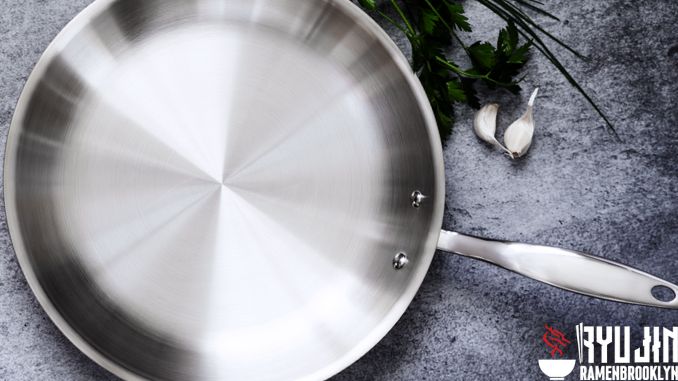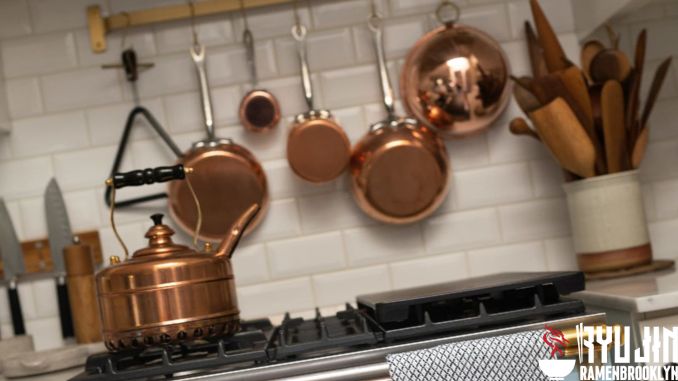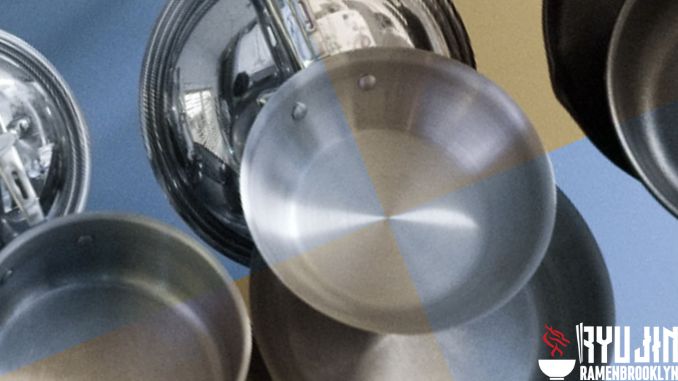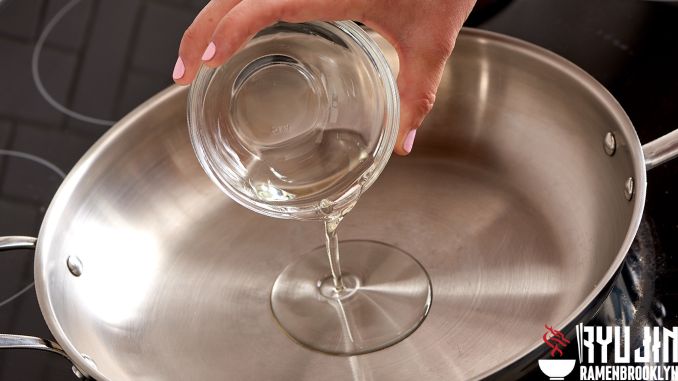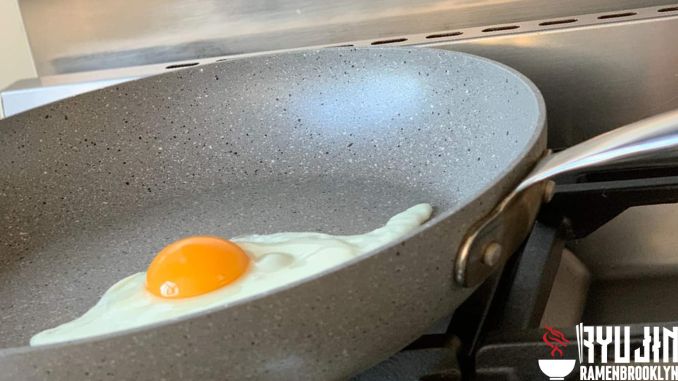What Is a Non Reactive Pan?
Are you looking for a new cookware set and unsure what to buy? Or are you having some questions about “what is a non reactive pan?“? Cooking food is a process that can take many forms. Some people enjoy cooking their food using simple methods, while others prefer to use more complicated techniques.
It is important to have the right cookware for your food because some pans react badly with certain ingredients. For instance, if you’re making jam or sauce and want it to taste delicious without suspicious tastes, this stainless steel pan will be perfect! It won’t react, so there’ll never come a mental flavor in what we eat off these dishes at dinner time.
To ensure the best results, we always recommend using “nonreactive” cookware when preparing recipes that call for brown sugar or juice. This means you should never use an aluminum pot because it will react with these ingredients and create a stain on your food!
It’s important to be specific about what type of pans are suitable in each recipe as well- some require stainless steel while others prefer cast iron – so make sure before starting any dish whether it’s baking soda emissions during the digestion process.
No matter your cooking style, a nonreactive pan is one piece of cookware you need in your kitchen. There are many different types to choose from, and you’ll find one that fits all those needs in seconds!
The pan you need to cook with will depend on the material it is made from. However, some pans can be used even if they lack a reactive coating because their design prevents food from contacting metal surfaces inside them; these include copper-based materials such as stainless steel and aluminum covered with titanium or nickel plating (which don’t affect foods).
To find out more about what is a non reactive pan and what kind of nonreactive cooking equipment would best suit your needs, read our article here! We’ll also explain everything you need to know about nonreactive pans and why they’re important to any cook’s toolkit. Stay tuned!
- What Is a Non Reactive Pan?
- How to Identify a Non Reactive Pan
- Why Use a Non Reactive Pan?
- Types of Materials That are Considered to Be “Non Reactive”
- Food That Requires the Nonreactive Pan
- Benefits of Using a Non Reactive Pan
- How to Choose The Right Non Reactive Pan
- How to Care for Non Reactive Pan
- How to Use a Non Reactive Pan
- FAQs about nonreactive pan
- Why Should You Always Use a Wooden Spoon When Cooking with a Non Reactive Pan?
- The Best Brands of Non Reactive Pans on The Market Today
- Should You Replace Your Current Pots and Pans with Non Reactive Ones?
- What Are the Disadvantages of Using Non Reactive Pans?
- Are Non Reactive Pans Safe to Use?
- The Top Five Recipes That Are Perfect for Cooking in a Non Reactive Pan
- Non-stick Pans
- In Summary
What Is a Non Reactive Pan?
A nonreactive pan is a cooking vessel made from materials that do not react with foods cooked in them. This results in minimal flavor transfer and no metallic taste. In contrast, reactive cookware, such as aluminum and uncoated cast iron, can cause food to taste metallic.
Reactivity measures how much an object changes when exposed to acids, which can be anywhere from 0-14 on the scale (0 being no change at all). A reactive pan will react in some way while cooking. Usually, this means it becomes etched or dulled over time because more than just surface protection is involved. So, you’ll also see bubbles forming on its bottom near vents where steam goes out into your kitchen appliance! Nonreactivity doesn’t offer as many guarantees but manages pretty well without reacting too seriously whenever we put something truly basic like tomatoes through the food processor.
The most common material used to make nonreactive pans is stainless steel. This material is not only nonreactive but also durable and easy to clean. Other popular materials used for nonreactive cookware include anodized aluminum and ceramic-coated aluminum. These materials are also nonreactive and offer a variety of benefits, such as being lighter in weight than stainless steel and providing even heat distribution.
As a result, they are ideal for dishes that require delicate seasonings, such as stir-fries or certain types of seafood. Many cooks also appreciate their ease of care – since they can be washed in the dishwasher without fear of damage. In addition, nonreactive pans come in various shapes and sizes, making them an essential piece of cookware for any kitchen.
Generally speaking, we do not recommend using reactive metals for cookware, such as unlined copper or those made from raw aluminum. There are some exceptions to this rule, though. For example, the caramel pan is made out of stainless steel, which allows making sauces easily because it doesn’t discolor when exposed to long periods at high temperatures (and there’s usually nothing acidic in cake batter) while also being able to withstand higher heats than other types/brand names we’ve tested so far without warping significantly – meaning less worry about burning your food!
When using acidic ingredients, tin, copper, and aluminum are the materials to avoid. However, if you have well-seasoned cast iron, it can be used with certain fruits or vegetables that produce an extra-strong response in those pans, making them perfect for tough stains like tomatoes, blood, or juice meatball sauce!
Our advice would be to buy good quality cookware as this will allow the food inside stays hot longer due to fewer hotspots which ultimately saves energy while also producing happier cooks who enjoy their work more because they’re not constantly worrying about breaking things. Those are the overview of the question of what is a non reactive pan, then I will go into details and some related questions about them.
See more: What’s Safe Cookware?
How to Identify a Non Reactive Pan
There are a few ways that you can identify a nonreactive pan. The first way is to look at the material that the pan is made from. As we mentioned, the most common material used for nonreactive cookware is stainless steel.
If you see that the pan is made from stainless steel, you can be sure that it is nonreactive. Another way to identify a nonreactive pan is to look at the bottom of the pan. If the bottom of the pan is smooth, then it is likely nonreactive.
If the bottom of the pan has a raised design or pattern, it may be reactive. Finally, you can also ask the salesperson at the store whether or not the pan is nonreactive.
Why Use a Non Reactive Pan?
Once you understand what is a non reactive pan, then you will probably need to know the values when using this pan. You would want to use a nonreactive pan for many reasons. The first reason is that it will prevent your food from tasting metallic. If you are cooking with acidic ingredients, such as tomatoes or citrus fruits, you will want to use a nonreactive pan.
Another reason to use a nonreactive pan is that it will help preserve the natural flavors of your food. If you are cooking a dish with delicate seasonings, such as fish or stir-fries, then you will want to use a nonreactive pan so that the flavors of the dish are not lost.
Finally, using a nonreactive pan is simply a personal preference. Some people prefer nonreactive cookware because it is easier to care for. These pans can simply be thrown in the dishwasher without fear of damage.
Types of Materials That are Considered to Be “Non Reactive”
There are a few different materials that are considered to be “nonreactive.” The most common material is stainless steel. This is because it contains a high percentage of chromium and nickel, making it resistant to corrosion. It is often used for cookware because it does not interact with food in the same way that other materials do.
Another common material is aluminum. This material is also used for cookware because it does not interact with food. However, it can be more difficult to care for than stainless steel.
Other materials used to make nonreactive pans include copper, glass, ceramic, and enameled cast iron. These materials are also not reactive but have different properties that make them better or worse for different tasks. For instance, copper conducts heat better than stainless steel but tarnishes more easily.
Enameled cast iron is another good option for nonreactive cookware. It has the added benefit of withstanding high temperatures, making it ideal for use on the stovetop.
Knowing what pain you’re using is important because it may affect how your meal turns out! For example, if acidic foods come into contact with copper-based metal pots or pans, they could damage the surface and interior material over time. All of them are due to their ability to absorb liquid from wet ingredients before heating them again at high temperatures, damaging their durability and giving off toxic chemicals when burned too brightly, causing fires.
So what is the best material to use? It depends on what you’ll be cooking. For example, if you want to cook a delicate fish or seafood dish, you’ll want to use a nonreactive pan so that the food doesn’t absorb any unwanted flavors from the pan. On the other hand, if you’re just looking for an all-purpose pan that can be used for various tasks, then stainless steel is a good option. Ultimately, it’s up to you to decide what material is best for your needs.
Food That Requires the Nonreactive Pan
Certain dishes require the use of a nonreactive pan. One of the most common examples is ceviche. Ceviche is a dish made with raw fish “cooked” in citrus juice. The acid in the citrus juice “cooks” the fish, and if you were to use a reactive pan, the metal would interact with the acid and give the ceviche a metallic taste.
Another example of a dish that requires a nonreactive pan is tomato sauce. Tomato sauce is also acidic, and if you used a reactive pan, it would interact with the acid and give the sauce an off-flavor.
Jams and juices – Most fruits, especially citrus, contain fruit acids that can damage the reactive pan. Malic or citric acid attracts metal atoms out of materials such as copper cast iron aluminum. Hence, it is best to take an un-sensitive saucepan for preparing these foods if you want a long-lasting product.
The best way to prevent your pan from corrosion is by adding salt at the end of cooking. If you’re using a copper or aluminum pot, then any food must be cooked long enough before serving so as not to cause further damage with high levels of sodium intake! Salty dishes like salsa and pasta sauces also require nonreactive pots to not corrode fast.
When storing food with vinegar, use a pan that will not react. Pickles and sauerkraut are high in acidity, so they should only rest on nonreactive surfaces for an extended period if you want your dish to taste fresh without any discoloration or stains from contact time while still being able to consume all its nutrients!
In this case, it is best not to use an aluminum utensil as it will react when exposed for too long periods and cause stains on your product which may lead to staining other dishes in future cooking sessions if left unchecked.
The vegetable rhubarb’s bright and juicy red stalks are often used in desserts. The plant has been known to cause damage when cooked because it contains too much acid for pans commonly found in home kitchens today- this means you’ll need special equipment (a nonreactive pan)!
In general, any dish that contains acidic ingredients should be cooked in a nonreactive pan. This includes dishes like stir-fries, marinades, and vinaigrettes. Should learn carefully about what is a non reactive pan and its basic characteristics so you can use them in the most accurate and safest way.
Benefits of Using a Non Reactive Pan
There are several benefits to using a nonreactive pan. One of the most important benefits is that it prevents the food from interacting with the metal and taking on a metallic taste.
Another benefit is that it prevents the formation of harmful compounds when cooking acidic foods at high temperatures. When acidic foods come into contact with reactive metals, they can form harmful compounds known as carcinogens.
Lastly, using a nonreactive pan can help extend your cookware’s life. Reactive metals such as copper and aluminum can rust over time when exposed to acid-rich foods.
How to Choose The Right Non Reactive Pan
As you can see, many different types of nonreactive pans can choose from. The best way to choose the right one is to consider what type of cooking you will be doing. If you plan on cooking acidic foods, you will need a pan made from a nonreactive material. Some examples of nonreactive materials include glass, enamel, stainless steel, or anodized aluminum.
The choice between different materials of cookware is an important one. For example, some people might prefer aluminum because it’s lightweight and durable, while others may want copper for its brighter appearance or tin-lined pans that are non-stick but don’t react with food – these last two features make them great choices if you have children around who love cooking!
You can also purchase glass dishes which will allow more light into your kitchen at night time since they’re clear instead of the dark sandwich we’ve often seen Paramount white or black colors.
You can prepare whatever you want in your copper pan with the stainless steel interior finish. On the contrary, if it has a thin copper lining, then only certain recipes will work for this type of cookware. Others cannot even begin to try them out due to their poor conductivity when heated up, which limits how many foods one may consume use throughout the meal preparation process. Also, creates other problems such as corrosion from chemicals found within kitchen pantry items over time, so be sure before purchasing any new piece that meets all safety standards!
If you are looking for a durable and easy-to-clean pan, you may want to consider anodized aluminum or stainless steel. If you want a lightweight pan that has a bright appearance, then copper might be the right choice for you.
Also, you can check what material the pan is made of by looking for a label that says “nonreactive” or “safe for acidic foods.”
The brochure must contain all of this information when you buy a pan. Make sure to read about what materials are used in its construction and how they can be cared for so your new cookware will last as long as possible!
The price of this pan is a little more than what you would expect for reactive cooking pans, but it will last much longer. Plus, there’s no risk that toxic particles could contaminate the food in your dish because they’re not made out of any metals or other materials that might leach into dishes during the heating process.
Some characteristics, benefits, and foods can be cooked with non reactive pan above, if you have any questions, can contact me, including the external questions, excluding “What is a non reactive pan “. Next, I will share with you how to maintain them to be able to use them for as long as possible.
How to Care for Non Reactive Pan
Once your investment pays off, you want to be able to use it for many years without having any concerns about its quality fading. Proper care and maintenance are critical when cooking with new pots or pans!
If something starts happening, like paint starting to wear away from the surface – don’t worry: this usually means that they’re just past their prime and should end up getting replaced soon enough so as not to risk exposing yourself to potentially harmful materials inside them while preparing meals at home.
Use a soft brush to gently remove food particles from your nonreactive pans. Avoid using hard scrubbing sponges and steel wool, which can scratch the surface of these types of coating damage is not desired or needed for any reason whatsoever! In most cases, warm soapy water works well enough to clean them without too much difficulty.
Even though nonreactive enamel pans have sensitive surfaces, you should still use mild soap and a sponge or natural brush. If there are leftover bits of food on the pan edges, soak it for half an hour before scrubbing gently to get rid of any residue that may be left behind from previous uses.
New pans can also go in the dishwasher if possible, so long as there’s no plastic coating. To test if your new pans will go well in a dishwasher or not, try running some water through it before putting anything else into its basket to see how efficiently they’re able to clean up food spills from disks uppermost.
The best way to maintain your stainless steel or glass cookware is by never washing them before cooling completely. If you do, temperature shock will damage the dish and maybe even crack it over time; besides, there are specific polishes for preserving shine on these pans that I recommend buying if this interests you!
Baking soda is a versatile cleaning agent that can be used on all pans, but avoid using bleach and never put nonreactive dishes in the same load as reactive ones. Some skillets may get dark stains over time – this isn’t an issue for which you should resort to bleaching agents.
Baking Soda is one of those things that sounds too simple, but it went back centuries ago! Back when our ancestors were still learning how to cook over open fires or hearths, they realized 2 important truths:
1) Even though metal pots may conduct heat well enough for some purposes (like making tea), their ability unpredictable changes based on what’s happening around them.
2) If there are any traces of food or grease on the surface of a pot, it’s hard to clean them off without using some abrasive material.
So what did they do? They started using ashes and sand to clean their pots, which worked! Not only was it effective in removing any unwanted residue, but it also helped to season the pots (which made them better at conducting heat).
Eventually, people realized that baking soda had all the same properties as ashes and sand–but without the risk of scratches. That’s why it’s become such a popular cleaning agent.
How to Use a Non Reactive Pan
As I mentioned above, knowing their basic information towards our ultimate goal is the safest way to use them. I wrote this article, “What is a young Reactive Pan?”, of course, we will show you how to use them.
When cooking with a new pan, it’s best to start seasoning the surface before using it for the first time. This will help create a non-stick barrier between food and the cookware so that nothing sticks and prevents rusting or corrosion down the line.
To season your pan, heat it on the stove over low heat for about 10 minutes. Then, turn off the burner and add some oil to coat the entire surface of the pan – use canola or vegetable oil, taking care not to pour in too much.
Afterward, use a paper towel to wipe away any excess before putting the pan back on low heat for another 10 minutes. Let it cool completely before using it as usual; you may need to repeat this process a few times before getting the desired result, but it’s worth it in the long run!
One thing to remember when cooking with nonreactive pans is that they don’t conduct heat as well as other types of cookware. This means you’ll need to use lower temperatures than what’s called for in recipes so as not to risk burning your food.
You’ll also want to be careful not to use metal utensils on these surfaces, as they can scratch and damage the coating over time. Instead, opt for wooden or silicone spatulas and spoons – anything that won’t react with the pan’s surface.
The nonreactive enamel or glazed finishes of pots can discolor when exposed to certain ingredients like red wine, so don’t use them for food items that will stain. There’s also some concern about chipped surfaces, and aluminum is considered safe if anodized (time eventually wears down this protection), but once the finish has been compromised by chips/scratches, it should no longer be used on anything else either because there are health risks involved with damaged cookware!
In general, nonreactive cookware is best used for dishes that aren’t too acidic, like eggs, pancakes, or proteins that have been pan-seared. On the other hand, if you’re looking to make something like tomato sauce, it’s best to use a different pot or pan.
FAQs about nonreactive pan
Above, I have raised you all the main information related to the question “What is a non reactive pan?“, But that is not enough, there is much other information to note in Quartstrinhf using them. Read more to know common questions to know tips when using non reactive pan.
Why Should You Always Use a Wooden Spoon When Cooking with a Non Reactive Pan?
When cooking with a non reactive pan, it is important to always use a wooden spoon or other wooden utensils. Non reactive pans are made from materials (such as stainless steel, aluminum, and enameled iron) that are not easily corroded by acidic ingredients such as vinegar or lemon juice. The use of metal utensils can cause the surface of the pan to become scratched and pitted, which will make it more prone to corrosion and discoloration over time.
Wooden spoons are ideal for stirring ingredients in a non reactive pan because they won’t scratch the surface and they distribute heat evenly throughout the food being cooked. Additionally, wood has a low thermal conductivity which helps prevent the burning or sticking of foods. Furthermore, wood is naturally non-reactive and won’t react negatively with acidic ingredients.
When using a non reactive pan for cooking, it is important to always use a wooden spoon or other wooden utensils to ensure the longevity of the pan and the best results when preparing food. Doing so will save time and money in the long run as it will help keep your pans from becoming corroded or developing surface scratches that are prone to corrosion. In addition, using a wooden spoon helps distribute heat evenly throughout the food being prepared – for perfect results every time!
The Best Brands of Non Reactive Pans on The Market Today
Some brands make nonreactive pans, but some of the best include All-Clad, Le Creuset, and Lodge.
Should You Replace Your Current Pots and Pans with Non Reactive Ones?
If you’re looking to switch to nonreactive cookware, it’s unnecessary to replace all your pots and pans at once. Start by picking up a few key pieces, like a nonreactive skillet or saucepan, and use them for dishes that would benefit most from this cookware. Then, you can gradually add more pieces to your collection as needed.
What Are the Disadvantages of Using Non Reactive Pans?
Once you want to learn about what is a non reactive pan, you will definitely need to know about what cranes can happen when cooking with them. We will give you the following.
One of the main disadvantages of using nonreactive cookware is that they don’t conduct heat as well as other types of pots and pans. This means you’ll need to use lower temperatures when cooking to avoid burning your food. Additionally, these surfaces can be more delicate than others, so you’ll need to be careful not to use metal utensils as they can scratch the surface.
It can also be difficult to find nonreactive cookware in stores, as they’re not as widely available as other types of pots and pans. However, a little searching can usually find what you’re looking for online.
Are Non Reactive Pans Safe to Use?
Yes, non reactive pans are safe to use as long as they’re not damaged. Once the finish on these pans is compromised, there are health risks involved, so be sure to check for chips or scratches before using them. Also, be sure to use lower temperatures when cooking to avoid burning your food.
Finding out details about what is a non reactive pan will help you understand whether they are safe to use. Not only in this type of Bao but also includes any other cooking tools, you will also need to know the information about their characteristics and benefits to confirm whether they are safe to cook or not.
The Top Five Recipes That Are Perfect for Cooking in a Non Reactive Pan
-Eggs: Whether you’re making scrambled eggs, omelets, or sunny-side-up eggs, a nonreactive pan is a perfect choice. Be sure to use a lower temperature than what’s called for in recipes to avoid burning your food.
-Pancakes: Nonreactive pans are ideal for cooking pancakes because they’ll evenly distribute heat and prevent sticking.
-Seared proteins: If you’re looking to sear chicken, steak, or fish, a nonreactive pan is a way to go. Just be sure to use a lower temperature than what’s called for in recipes to avoid burning your food.
-Tomato sauce: This is one of the few recipes where a nonreactive pan isn’t the best choice. The acid in tomato sauce can react with the pan and cause off-flavors.
-Desserts: Nonreactive pans are perfect for desserts like cakes, brownies, and cookies. They’ll evenly distribute heat and prevent sticking.
Non-stick Pans
Adding a protective coating to non-stick pans has made them more appealing in recent years. These coatings prevent changes when cooking with food, so you can consider these skillets nonreactive. However, nothing is absolute; it is not entirely true for a non-stick pan without Teflon.
Not all non-stick pans are created equal! To ensure that your food won’t turn out badly due to a protective coating, you should do some tests with baking soda. One way is by boiling one tablespoon of this agent in the pan, after which time drink water from its bottom while steaming hot: if there’s no reaction, then congratulations–you’ve found yourself an effective anti-reactive material for cookware (just make sure not to react when cooking oil or butter).
On the other hand, if you notice any changes in taste or color, it would be best to refrain from using that particular pan. That’s all we want to share with you about what is a young Reactive Pan. If you have any questions or information to talk to us, you can leave a comment below, we will respond to you as quickly as possible.
See more: Is Ceramic Cookware Safe?
In Summary
The interior finish of a pan determines whether or not it will react with food. For example, stainless steel is nonreactive because there’s no metal inside to combine and create an aggressive bond when heated up at high temperatures like in ovens.
Whereas copper reacts very quickly, resulting in exfoliation, which can lead you to have cleaning problems later down the line if this type is used on top-level cooking equipment such as skillets, etc.
Aluminum has been known to be a workhorse metal. Still, it has one major drawback: its ability evaporates over time due to oxidation, making this material less durable in the long run.
Other materials like anodized aluminum and ceramic can also be used, but they each come with pros and cons, so be sure to do your research before making a purchase!
Nonreactive panning is a process of cooking in which the cookware doesn’t interact with the food being cooked. This is achieved using a material that doesn’t conduct heat well and is often coated with a non-stick surface. Nonreactive pans are ideal for cooking eggs, pancakes, and searing proteins.
However, they’re not perfect for every recipe. Tomato sauce, for example, can react with the pan and cause off-flavors. When using a nonreactive pan, be sure to use a lower temperature than what’s called for in recipes to avoid burning your food.
Additionally, be careful not to use metal utensils as they can scratch the surface. While non-stick pans are more effective than ever, be sure to do some tests with baking soda before using one to ensure it won’t react with your food.
Thanks for reading! We hope this article helped inform you about what is a non reactive pan. If you have any further questions, please feel free to reach out to us.
Anthony Michelin (March 26, 1960) is the CEO of Ryujinramenbrooklyn.com – is an expert in finding specialized equipment to assist in the Bar & Kitchen sector. With over 40 years of focus on finding the simplest recipes on the most suitable cookware to create the most delicious meals, I believe it will help you.
